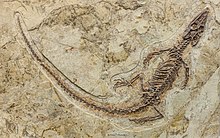| Choristodera | |
|---|---|

| |
| Skeleton of Philydrosaurus proselius exhibited at the National Museum of Natural Science, Taiwan | |

| |
| Skeleton of Ikechosaurus, on display at National Museum of Natural Science, Taiwan | |
| Scientific classification | |
| Domain: | Eukaryota |
| Kingdom: | Animalia |
| Phylum: | Chordata |
| Class: | Reptilia |
| Clade: | Neodiapsida |
| Order: | †Choristodera Cope, 1876 |
| Subgroups | |
| |
Choristodera (from the Greek χωριστός chōristos + δέρη dérē, 'separated neck'[2]) is an extinct order of semiaquatic diapsid reptiles that ranged from the Middle Jurassic, or possibly Triassic, to the Miocene (168 to 20 or possibly 11.6 million years ago). Choristoderes are morphologically diverse, with the best known members being the crocodile-like neochoristoderes such as Champsosaurus. Other choristoderans had lizard-like or long necked morphologies. Choristoderes appear to have been confined to the Northern Hemisphere, having been found in North America, Asia, and Europe, and possibly also North Africa. Choristoderes are generally thought to be derived neodiapsids that are close relatives or members of Sauria.
- ^ Brownstein, C. D. (2022). "High morphological disparity in a bizarre Paleocene fauna of predatory freshwater reptiles". BMC Ecology and Evolution. 22 (1): 34. doi:10.1186/s12862-022-01985-z. PMC 8935759. PMID 35313822.
- ^ Sues, H.-D. (2019). "Archosauromorpha: Choristodera". The Rise of Reptiles: 320 Million Years of Evolution. Baltimore, MD: Johns Hopkins University Press. pp. 167–168. ISBN 978-1-4214-2867-3.